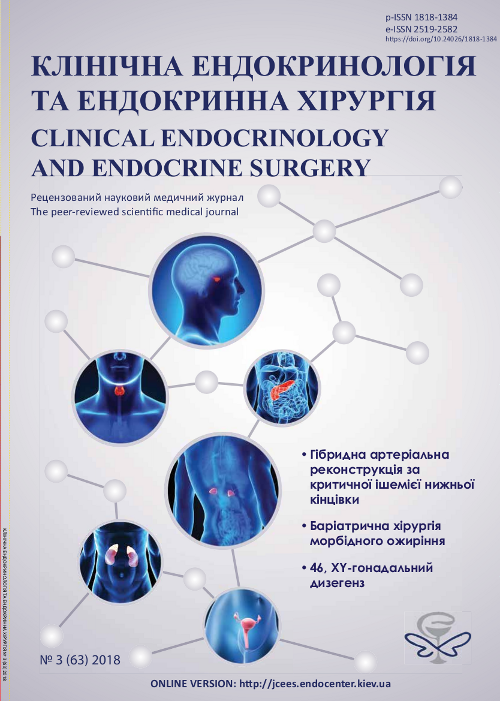Співвідношення основних філотипів кишкової мікробіоти у хворих на цукровий діабет 2 типу
DOI:
https://doi.org/10.24026/1818-1384.3(63).2018.142668Ключові слова:
кишкова мікробіота, цукровий діабет, Firmicutes, BacteroidetesАнотація
Дані, отримані у експериментальних та нечисленних клінічних дослідженнях, свідчать про значну різницю у вмісті двох основних бактеріальних типів (Firmicutes та Bacteroidetes) при цукровому діабеті 2 типу, хоча результати різних досліджень нерідко мають суперечливий характер. Окрім того, в літературі немає даних щодо змін вмісту основних філотипів кишкової мікробіоти в залежності від тяжкості перебігу та компенсації діабету.
Мета дослідження – вивчити вміст основних філотипів кишкової мікробіоти у хворих на цукровий діабет (ЦД) 2 типу при різній тяжкості його перебігу та в залежності від стану компенсації.
Матеріал та методи. Обстежено 64 хворих на ЦД 2 типу (29 чоловіків та 35 жінок) віком від 30 до 72 років (середній вік 47,3±8,9 року), а також 30 здорових добровольців, які склали групу контролю. Проводились клінічні, лабораторні та молекулярно-генетичні дослідження (визначення ДНК Firmicutes, Bacteroidetes та Actinobacteria методом кількісної ПЦР у режимі реального часу з застосуванням ген-націлених праймерів).
Результати. Встановлено, що вміст Firmicutes у хворих на ЦД 2 типу був достовірно вищим, а вміст Bacteroidetes – достовірно меншим порівняно зі здоровими особами. У міру підвищення тяжкості ЦД та погіршення його компенсації вміст Firmicutes також достовірно збільшувався, а вміст Bacteroidetes – знижувався, відповідно, підвищувалось і співвідношення F/B.
Висновки. Деякі порушення складу кишкової мікробіоти, зокрема, зниження загальної кількості Bacteroidetes, підвищення кількості Firmicutes та співвідношення F/B, можуть відігравати патогенетичну роль не лише у розвитку ЦД 2 типу, але й сприяти погіршенню його перебігу та компенсації.
Посилання
Amar J, Serino M, Lange C. Involvement of tissue bacteria in the onset of diabetes in humans: evidence for a concept. Diabetologia. 2011; 54:3055–61.
Apovian CM. The obesity epidemic – understanding the disease and the treatment. N Engl J Med. 2016 Jan 14; 374(2):177-9.
Arumugam M, Raes J, Pelletier E, et al. MetaHIT Consortium. Enterotypes of the human gut microbiome. Nature. 2011; 473:174–180.
Baothman OA, Zamzami MA, Taher I, Abubaker J, Abu-Farha M. The role of Gut Microbiota in the development of obesity and Diabetes. Lipids Health Dis. 2016 Jun 18; 15:108.
Bouter K, van Raalte D, Groen A, Nieuwdorp M. Role of the Gut Microbiome in the Рathogenesis of Obesity and Obesity-Related Metabolic Dysfunction. Gastroenterology. 2017; 152:1671–1678.
Cani PD, Amar J, Iglesias MA, et al. Metabolic endotoxemia initiates obesity and insulin resistance. Diabetes. 2007; 56:1761–1772.
Cani PD, Osto M, Geurts L, Everard A. Involvement of gut microbiota in the development of low-grade inflammation and type 2 diabetes associated with obesity. Gut Microbes. 2012 Jul-Aug; 3(4):279-88.
Bacchetti De Gregoris T, Aldred N, Clare AS, Burgess JG. Improvement of phylum- and class-specific primers for real-time PCR quantification of bacterial taxa. J Microbiol Methods. 2011 Sep; 86(3):351-6.
De Vadder F, Kovatcheva-Datchary P, Goncalves D, et al. Microbiota-generated metabolites promote metabolic benefits via gut-brain neural circuits. Cell. 2014; 156:84–96.
Diabetes Advocacy: Standards of Medical Care in Diabetes – 2018. Diabetes Care. 2018; 41(Suppl. 1): 159 р. (doi.org/10.2337/dc18-S015)
Eckburg PB, Bik EM, Bernstein CN, et al. Diversity of the human intestinal microbial flora. Science. 2005 Jun 10; 308(5728):1635-8. Epub 2005 Apr 14.
Everard A, Cani PD. Diabetes, obesity and gut microbiota. Best practice & research. Clinical gastroenterology. 2013 Feb; 27:73–83.
Hartstra A, Bouter К, Backhed F, Nieuwdorp М. Insights Into the Role of the Microbiome in Obesity and Type 2 Diabetes. Diabetes Care. 2015; 38:159–165.
Jandhyala SM, Talukdar R, Subramanyam C, et al. Role of the normal gut microbiota. World J Gastroenterol. 2015; 21:8787–8803.
Karlsson FH, Tremaroli V, Nookaew I, et al. Gut metagenome in European women with normal, impaired and diabetic glucose control. Nature. 2013; 498:99–103.
Kootte RS, Vrieze A, Holleman F, et al. The therapeutic potential of manipulating gut microbiota in obesity and type 2 diabetes mellitus. Diabetes Obes Metab. 2012; 14:112–120.
Larsen N, Vogensen FK, van den Berg FW. Gut microbiota in human adults with type 2 diabetes differs from non-diabetic adults. PLoS One. 2010; 5:e9085.
Le Chatelier E, Nielsen T, Qin J. Richness of human gut microbiome correlates with metabolic markers. Nature. 2013; 500:541–6.
Musso G, Gambino R, Cassader M. Obesity, diabetes, and gut microbiota: the hygiene hypothesis expanded? Diabetes Care. 2010; 33:2277–84.
Nieuwdorp M, Gilijamse PW, Pai N, Kaplan LM. Role of the Microbiome in Energy Regulation and Metabolism. Gastroenterology. 2014; 146(6):1525–1533.
Plovier H, Everard A, Druart C, et al. A purified membrane protein from Akkermansia muciniphila or the pasteurized bacterium improves metabolism in obese and diabetic mice. Nat Med. 2017; 23:107–113.
Pussinen PJ, Havulinna AS, Lehto M, Sundvall J, Salomaa V. Endotoxemia is associated with an increased risk of incident diabetes. Diabetes Care. 2011; 34:392–7.
Qin J, Li Y, Cai Z, et al. A metagenome-wide association study of gut microbiota in type 2 diabetes. Nature. 2012; 490:55–60.
Sanz Y, Olivares М, Moya-Perez А, Agostoni С. Understanding the role of gut microbiome in metabolic disease risk. Pediatric Research. 2015; 77(1-2): 236-244
Tilg H, Kaser A. Gut microbiome, obesity, and metabolic dysfunction. J Clin Invest 2011; 121:2126–2132
Wu X, Ma C, Han L. Molecular characterisation of the faecal microbiota in patients with type II diabetes. Curr Microbiol. 2010; 61:69–78.
Zhang X, Shen D, Fang Z. Human gut microbiota changes reveal the progression of glucose intolerance. PLoS One. 2013; 8:e71108.39.
Zhang BW, Li M, Ma LC, Wei FW. A widely applicable protocol for DNA isolation from fecal samples. Biochem Genet. 2006 Dec; 44(11-12):503-12.
Zhu B, Wang X, Li L. Human gut microbiome: the second genome of human body. Protein Cell. 2010; 1:718–725.
##submission.downloads##
Опубліковано
Як цитувати
Номер
Розділ
Ліцензія
Авторське право (c) 2018 Клінічна ендокринологія та ендокринна хірургія

Ця робота ліцензується відповідно до Creative Commons Attribution 4.0 International License.





